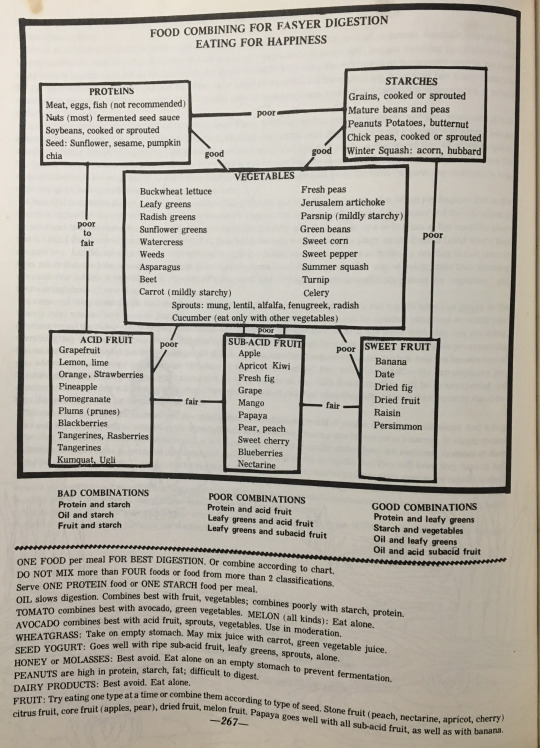#do not take nutrition advice from breatharians
Text
Food Combining For Easyer Digestion - Eating For Happiness
Survival Into The 21st Century: Planetary Healers Manual by Viktoras Pisces Kulvinskas. Omangod Press (1975).

#do not take nutrition advice from breatharians#food#recipe#recipes#cooking#vintage recipe#vintage cooking
22 notes
·
View notes
Text
“Food Facts and Fads”
“The history of every major galactic civilization tends to pass through three distinct and recognizable phases, those of Survival, Inquiry and Sophistication, otherwise known as the How, Why and Where phases. For instance, the first phase is characterized by the question How can we eat? the second by the question Why do we eat? and the third by the question Where shall we have lunch?" – Douglas Adams
I’ll be teaching a new course this semester “Food Facts and Fads” (#FDSC105). This is a general education course (Health and Physical Activity, GHA) that surveys the food system. It is NOT a nutrition class and I really don’t want to tell anyone what to eat. I would like to encourage students to think in different ways about the food choices they do make.
As “Facts and Fads” suggests, part of this course is about how we decide something is true or not which drags us dangerously close to the history and philosophy of science. One way to interpret the title would be to look at how science has led us out of darkness to the perfectly rational diet we all eat today but that just isn’t true. People have always believed all sorts of weird things about food. Science goes some way to resolve the confusion, but usually in complex and incomplete ways. Interesting ways.
We will take a historical perspective and look at the ways people have fed themselves in the past (Past 1), we then look at the development of the food system that feeds us now looking at specific food groups and commodities (Part 2). In Part 3 we look at how we came to think of food as healthy, nutrition. Remember though, this isn’t trying to teach you nutrition science; we are looking at how people think about food in terms of nutrients. (This distinction will become clearer when we get there!) Of course, people choose food for lots or reasons other than nutrition and we’ll look at some of those in Part 4. Part 5 is about trends and fads and how things might taste in the future.
(you can read the course notes here)
Part 1: Snapshots from the history of food – examples of food systems
1. Course introduction. The idea of a biosphere, foraging, the idea of a food system
2. Beginnings of agriculture, peasant farming, lactose tolerance, need for processing (drying, salting, fermenting), resulting social changes
3. Some historic food systems – Food in the Roman Empire and the Han Empire, the Columbian Exchange and the Spice Trade. Industrialization and modernity – development of the Chicago Stockyards
4. When systems fail - Hunger and famine, Sen, Historic famines, Lion’s pantry
Part 2: Where does my food come from?
5. Canned food – Appert, Pasteur, Prescott, home canning
6. Frozen food - The social history of ice, Clarence Birdseye, fish sticks
7. Fresh food in season and out of season – Harner farms, Salads from Mexico, Orange juice from Florida, food waste
8. Cereals – Corn as a commodity, source for ingredients.
9. Meat – processes, welfare issues, Temple Grandin, Penn State Meats lab
10. Dairy – practical challenges of a modern Pa dairy farm and the Penn State Creamery
11. Exam
12. Chocolate – Hershey, global issues
Part 3: Modern ideas of nutrition.
13. Discovery of vitamins, deficiency diseases, going from food to nutrients, supplementation, Vitamania, other micronutrients
14. Macronutrients, the calorie, weight loss and obesity
15. How can we establish a link between food and health? Types of nutritional study and their limitations, Phytochemicals. Government dietary advice – MyPlate vs. Marion Nestle.
16. Other dietary advice – types of diet (and evidence), sugar vs. fat debate, protein for muscle.
17. The story of margarine.
Part 4: Is food “good”?
18. Enjoyment – feasts and comfort food, measuring hedonics, psychological factors, eating disorders, disgust.
19. Law – adulteration, Pure food laws, horsemeat scandal
20. Ethical and religious concerns – some ethical frameworks, “Consider the Lobster”, dog or horse meat consumption, animal rights, Jewish food law (?).
21. Exam
22. Social costs and public health – Euthenics, home economics, alcohol and prohibition, attempt to reduce salt in foods, responses to the obesity crisis.
23. Toxicity – natural toxins, added toxins, the poisons squad, Gwyneth Paltrow, risk and risk perception, caffeine toxicity.
24. Culture –development, Vandana Siva vs. Norman Borlaug, pearl millet processing in Senegal, culinary cultural appropriation, local food (the Penn State Farm), General Tso’s Chicken.
25. Environment – Organic food, GMOs
26. Microbial food safety
27. THANKSGIVING
28. THANKSGIVING
Part 5: Trends and Fad Diets
29. Early 20th century fads – breatharians, Kellogg’s sanatorium, the great masticator
30. Early 21st century fads – “Real food”, ”Clean food”, Gluten free, Paleo, bio-hacking
31. How the food industry responds to trends
32. The Future – Space food, insects, vegan meats. Final thoughts
Finals week - Exam 3
2 notes
·
View notes
Text
The Color In Your Diet, by Peter the Healer
Survival Into The 21st Century: Planetary Healers Manual by Viktoras Pisces Kulvinskas. Omangod Press (1975).

#do not take nutrition advice from breatharians#food#recipe#recipes#cooking#vintage recipe#vintage cooking
5 notes
·
View notes
Text
Seed Yogurt
Survival Into The 21st Century: Planetary Healers Manual by Viktoras Pisces Kulvinskas. Omangod Press (1975).

#do not take nutrition advice from breatharians#food#recipe#recipes#cooking#vintage recipe#vintage cooking
6 notes
·
View notes